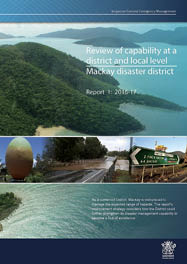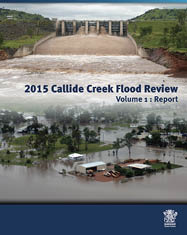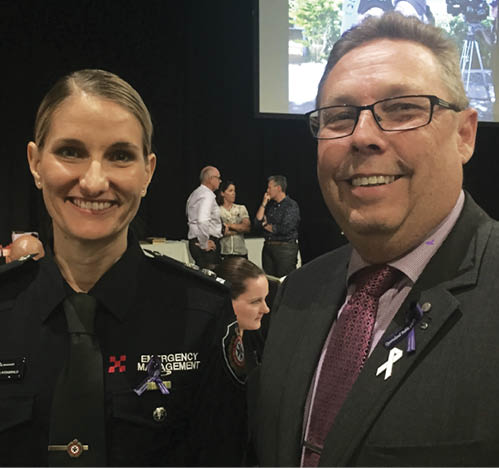Queensland IGEM: results achieved so far
Iain MacKenzie, Queensland Inspector-General Emergency Management
Article
The vision for the Queensland Office of the Inspector-General Emergency Management (IGEM) is to be a catalyst for excellence in emergency management. Central to achieving this is a genuine need for commitment to authentic and thorough engagement—from the ground up. This is essential for real change and enhanced confidence in Queensland’s disaster management arrangements.
In 2014 our stakeholders from across the sector worked closely with the newly established Office of the IGEM to build the foundations for future work. Through this consultation we now have our first Strategic Plan1 and the Emergency Management Assurance Framework, and Queensland’s first Standard for Disaster Management2.
Assurance activities
Using the Framework and the Standard as foundations, IGEM has undertaken comprehensive assurance activities. These are:
- eight reviews
- 2014 Callide Creek Flood Review
- Review of Local Government’s Warning Capability
- Review of State Agency Integration at a Local and District Level
- Review of Cyclone and Storm Tide Sheltering Arrangements
- Review of Seqwater and SunWater Warnings Communications
- Review of Aboriginal and Torres Strait Islander Council’s Capability to Deliver Disaster Management Responsibilities
- Review of Capability at a District and Local Level: Warwick disaster district
- Mackay District and Local Capability Review
- two discussion papers
- Evaluation of Emergency Management Training and Exercising
- Analysis of Disaster Management Exercises (an analysis of documents relating to 152 disaster management exercises carried out between 2010 and 2015 to identify trends, innovation and good practice)
- a research paper into best practice emergency supply
- a commissioned evaluation of the improvement in the State Disaster Coordination Centre; Room for Improvement Report June 2014
Importantly, the evidence-based recommendations coming from these reviews have been strongly embraced. Of these recommendations, 99 per cent have been accepted by the entities involved. My strong desire is for the findings and recommendations to be considered as opportunities for improved outcomes to the community as this is where our collective focus needs to be.


Enhancing disaster management excellence
To enhance disaster management excellence at the local level, the IGEM has developed:
- an online process to assess local and district disaster management plans
- an online prioritisation tool for entities to undertake a ‘health check’ of their disaster management arrangements against the Standard
- a series of fact sheets, Accountabilities in Practice, for disaster management practitioners.
Workshops explaining the Standard have been held across Queensland for members and chairs of local and district disaster management groups. This has proved beneficial to build the level of communication, collaboration and partnering with our disaster management stakeholders.

Inspector-General Iain MacKenzie and 2017 IGEM Champion of Change Award recipient, Cheryl-Lee Fitzgerald, Executive Manager Emergency Management, Queensland Fire and Emergency Services. Image: IGEM
As part of this, a Disaster Management Officer Network was established to allow local practitioners to connect, keep up with developments in disaster management arrangements and associated doctrine and to share and develop their skills, knowledge, resources and ideas. The network ran a three-day forum in Cairns in May 2016 and has now grown to over 70 officers from more than 50 local governments and one member from the Local Government Association of Queensland.
Our focus on collaboration, partnerships and engagement continues through:
- creating the IGEM Advisory Panel for practical advice from stakeholder groups
- publishing the e-newsletter ‘IGEM Connect’, going out to 1200 subscribers
- partnering with local disaster management practitioners in the Wide Bay and North Burnett region to study disaster management arrangements for seniors living in their own homes
- partnering with individuals and agencies through initiatives such as GovHack
- establishing online platforms to support networking and encourage good practice and sharing of ideas
- developing a multi-faceted research framework with industry and the tertiary sector for high-quality research that contributes to continuous improvement in practice and community outcomes
- creating a partnership with Queensland University of Technology on a range of activities (IGEM hosted a student intern to research potential uses of immersive technologies such as augmented reality and virtual reality)
- progressing the Queensland disaster management lexicon
- presenting the IGEM Champion of Change Award3.
The IGEM also meets with mayors and senior executives from local governments throughout Queensland. My staff frequently address local and district disaster management group meetings, speak at local, national and international conferences and participate in exercises, workshops, forums and symposiums.
Impacts and outcomes so far
Our ground-up approach has been well-received as reflected in stakeholder satisfaction with our work. Overall, 83 per cent of our stakeholders were either ‘satisfied’ or ‘very satisfied’ with the services and advice provided by the IGEM.
I am proud of the outcomes achieved and the improvements delivered so far by the sector, some of these include:
- changes to legislation with the Water Legislation (Dam Safety) Amendment Bill
- development of the new policy by the Department of Communities, Child Safety and Disability Service: People with vulnerabilities in disasters – a framework for an effective local response
- better systems in place via the new flood gauge network in the Callide Valley
- keeping communities informed
- identifying opportunities like immersive technologies and data sharing
- Queensland Fire and Emergency Services progression of integrated risk-based planning with stakeholders
- developing consistent disaster management terminology
- improved information and warnings systems for those living downstream from dams.
My goal for the coming years is to take the excellent work so far to the next level and to deliver the best possible disaster management arrangements for all Queensland.
For more information visit the IGEM website at www.igem.qld.gov.au.
Footnotes
1 IGEM Strategic Plan. At: www.igem.qld.gov.au/reports-and-publications/Pages/Strategic-Plan.aspx.
2 IGEM Standard for Disaster Management. At: www.igem.qld.gov.au/assurance-framework/Pages/standard.aspx.
3 The Champion of Change Award was established to create equity and diversity in the workplace. It is open to those who actively champion change to bring about greater equity for women in the Queensland disaster management sector.


